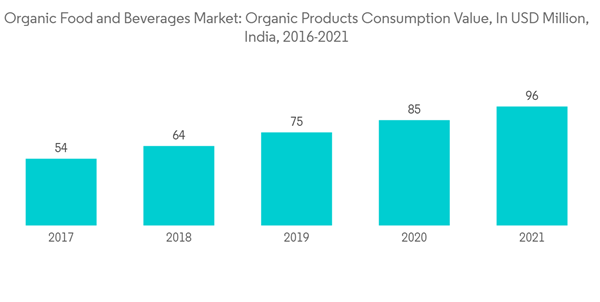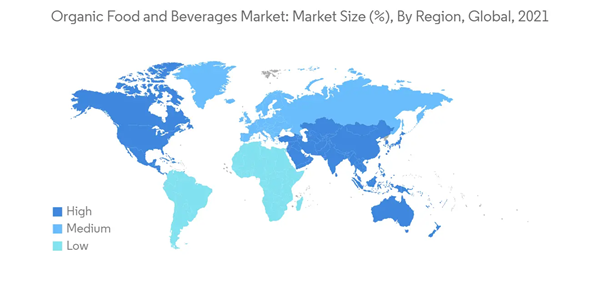The Organic Food and Beverages Market size is estimated at USD 174.37 billion in 2024, and is expected to reach USD 233.56 billion by 2029, growing at a CAGR of 6.02% during the forecast period (2024-2029).
The primary factor driving the expansion of the global organic food and beverages market is consumers' quicker adoption of healthy and natural foods and beverages. Increasing consumer awareness about the health and benefits of organic food products has further stimulated market growth. People are choosing organic food and drink more frequently. To meet the rising consumer demand, various manufacturers are creating labeled organic foods and drinks, such as juice with natural fruit ingredients and no added sugar. Moreover, with the growing number of chronic diseases such as cardiac issues, cancer, diabetes, and the rise in healthcare costs, consumers are increasingly focusing on their diet. This is one of the primary reasons driving the organic food and beverages market.
Moreover, the government's involvement in the organic food and beverages market, where the government has taken various initiatives to differentiate between false and actual labeling, has attracted consumers to the organic foods and beverages market. Also, the market growth can be attributed to the consumer's belief that organic food products are safer, more nutritious, and better in taste than conventional food items. Thus, the factor drives the per capita spending in this specific market.
The COVID-19 pandemic has significantly affected the organic food and beverages market. Due to this uncertainty, consumers' purchase patterns have changed as the consumers become aware of the necessity of a robust immune system; therefore, consumers have preferred more organic and natural foods. For example, General Mills Inc., one of the major players in this specific industry, has witnessed a growth of 8% in net sales per its annual company report. Thus, the pandemic had a positive effect on this market.
This product will be delivered within 2 business days.
The primary factor driving the expansion of the global organic food and beverages market is consumers' quicker adoption of healthy and natural foods and beverages. Increasing consumer awareness about the health and benefits of organic food products has further stimulated market growth. People are choosing organic food and drink more frequently. To meet the rising consumer demand, various manufacturers are creating labeled organic foods and drinks, such as juice with natural fruit ingredients and no added sugar. Moreover, with the growing number of chronic diseases such as cardiac issues, cancer, diabetes, and the rise in healthcare costs, consumers are increasingly focusing on their diet. This is one of the primary reasons driving the organic food and beverages market.
Moreover, the government's involvement in the organic food and beverages market, where the government has taken various initiatives to differentiate between false and actual labeling, has attracted consumers to the organic foods and beverages market. Also, the market growth can be attributed to the consumer's belief that organic food products are safer, more nutritious, and better in taste than conventional food items. Thus, the factor drives the per capita spending in this specific market.
The COVID-19 pandemic has significantly affected the organic food and beverages market. Due to this uncertainty, consumers' purchase patterns have changed as the consumers become aware of the necessity of a robust immune system; therefore, consumers have preferred more organic and natural foods. For example, General Mills Inc., one of the major players in this specific industry, has witnessed a growth of 8% in net sales per its annual company report. Thus, the pandemic had a positive effect on this market.
Organic Food and Beverages Market Trends
Increasing Demand for Clean Label Products
The organic food and beverage industry is anticipated to grow significantly due to the surge in demand for Clean-label food and beverage products. Consumers are much more aware of the foods and beverages they consume. To ensure that every product is organic and sustainable, they want to learn about the food and drink ingredients, their source, and government authority certificates. With the changing lifestyle, consumers are more conscious about their health. Therefore, consumers prefer more organic food and beverages than any other confectionary food; for example, France has witnessed a significant increase in organic food consumers consuming these products with a common motive of health benefits. This is because organic food and beverages provide consumers with good health benefits, as these organic products are preservative-free and are produced using natural ingredients. Organic animal-based products such as meat and chicken are also GMO-free. Due to the emerging demand for organic food, sales growth is rising concurrently. The need for organic food is increasing thus, as consumers prefer more natural food and beverages instead of chemically preserved foods, which is one of the significant reasons for driving the market growth.Asia-Pacific is the Fastest-Growing Market
The Asia Pacific is the fastest-growing market. This is because the major producers of these products are India and China. According to the APEDA, the total organic production of India was 3,240,349 metric tons in the year 2021. The consumer's awareness of the health benefits of organic food and beverages and the advancement in biological farming techniques are anticipated to drive the demand for organic food and beverages. These countries with the highest population also have a significant tendency to produce organic food and beverages because of the rising demands of consumers, which is one of the primary reasons driving the market. Furthermore, Governments assist farms in producing organic commodities. For instance, the Indian government is supporting organic agriculture through the Paramparagat Krishi Vikas Yojana (Traditional Agriculture Development Scheme). As part of the National Mission of Sustainable Agriculture. It provides producer guidelines for developing sustainable organic farming models through technical best practices, quality assurance, and institutional cluster-based producer models. The initiative provides farmers with financial support over three years at the rate of USD 671.2 per hectare.Organic Food and Beverages Industry Overview
The organic food and beverage market is highly competitive due to the involvement of many international and domestic players in the industry. The primary organic food and beverage market players include Amy's Kitchen, The Hain Celestial Group, General Mills, Conagra Brands, and Danone. Moreover, Private-label organic drink brands are also gaining prominence globally. The primary focus of the top players in the industry is the acquisition of small players. Some players also focus on product innovation to meet consumer needs and preferences. For instance, in 2021, General Mills Inc. acquired Tyson Foods, an American multinational corporation and the second-largest marketer and processor of chicken, beef, and pork around the globe. According to the company, the strategy behind the acquisition was to reshape the portfolio growth, which will help the company to expand its business.Additional Benefits:
- The market estimate (ME) sheet in Excel format
- 3 months of analyst support
This product will be delivered within 2 business days.
Table of Contents
1 INTRODUCTION
4 MARKET DYNAMICS
5 MARKET SEGMENTATION
6 COMPETITIVE LANDSCAPE
Companies Mentioned (Partial List)
A selection of companies mentioned in this report includes, but is not limited to:
- Amy's Kitchen, Inc
- Belvoir Fruit Farms Ltd
- Dean Food Company
- Danone - WhiteWave Foods
- General Mills Inc.
- Organic Valley
- United Natural Foods, Inc.
- Horizon Organic
- The Hain Celestial Group Inc
- ConAgra Brand
Methodology

LOADING...










